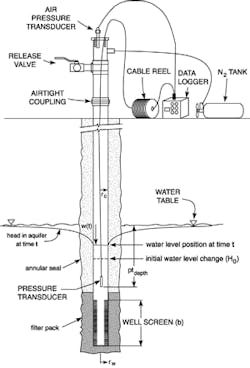by Jerry L. Mallams
Saltwater intrusion has been an ongoing issue in the southern west-central Florida ground-water basin (SWCFGWB), which serves as a public water source for domestic, utility, recreational, industrial and agricultural applications. The Southwest Florida Water Management District (SWFWMD) is conducting a comprehensive assessment of the risk that saltwater intrusion poses to the Upper Floridian aquifer water supply. The main goals of this extensive program are to explore and test existing conditions and to construct dedicated wells for future monitoring of water levels and water quality.
Today, using some of the latest technologically advanced level and pressure measurement instrumentation, the SWFWMD is expanding and improving this hydrogeological exploration program with the use of dedicated monitoring wells, aquifer performance tests and a water-quality sampling network.
The SWFWMD has constructed coastal monitor well transects consisting of two to three monitor and test sites. The program provides the opportunity to observe the movement of saltwater either landward or seaward. The data collected from these sites is used in the various water resource studies conducted to better manage the sensitive coastal aquifers of the SWCFGWB.
The first phase of this investigation includes discrete zone testing within a borehole with the use of a packer assembly. Water levels above the packer within the annulus are monitored to ensure the packer was properly sealed to the formation. Any water level fluctuation within the annulus would be very small, requiring precise water level measurements.
To achieve exact measurements, the SWFWMD is using Pressure System’s KPSI™ Series 335 Submersible Level Transducer. The small-bore transducer is ideal for monitoring this annulus and many other water level monitoring applications requiring static accuracy.
The SWFWMD also chose the Series 335 because the instruments are computer tested and calibrated, are fully temperature compensated and data logger compatible. In addition, the transducers feature internal signal conditioning and are available with standard voltage and current loop outputs.
During the packer test, the SWFWMD conducts a program of four or more slug tests consisting of a near-instantaneous stress or a slug being added (or removed) from the well. With a very permeable formation, these low magnitude slug tests result in a rapid water level response.
This program of slug tests is repeated every 50 to 100 feet as the borehole is advanced to depths of up to 3,000 feet below the land’s surface. In order to monitor the rapidly changing water levels during these tests, the SWFWMD again turned to Pressure System’s transducer for its high-speed data acquisition.
The SWFWMD uses the KPSI Series 735 Submersible Pressure Transducer, along with a ¼-inch nominal pipe thread, to measure air pressure within the pneumatic slug testing head to record the slug magnitude of the test. The submersible pressure transducer was used to accurately measure the water level displacements that occurred within the test interval. The 735 is ideal for recording pressure measurements within a close proximity, which is what the SWFWMD needed.
The SWFWMD also relies on the transducer for its ability to read pressure ranges from 0-2 psig through 0-100 psig as well as its on-board electronics that provide outputs of 4-20 mA. The compact instrument is constructed of 316 stainless steel and is designed for use in hostile environments.
About the Author: Jerry L. Mallams, PG, is manager of the Regional Observation & Monitor-well Program, Resource Conservation & Data Department, Southwest Florida Water Management District.




